University Nursing Ethics and Child Abuse Reflection Assignment
VerifiedAdded on 2022/09/18
|8
|3031
|16
Homework Assignment
AI Summary
This assignment explores the code of ethics in nursing, encompassing principles like autonomy, non-maleficence, beneficence, and justice. It includes reflections on ethical dilemmas using the Gibbs cycle, addressing scenarios related to patient care, vaccine administration, and prioritizing care. The assignment further examines child abuse, requiring reflection on engaging with caregivers, handling child disclosures, and understanding the impact of actions. Additionally, it addresses the ethical considerations in caring for the elderly, including personal views, workplace constraints, and case studies, emphasizing the importance of respect, patience, and providing quality care for all patients. The assignment covers topics related to ethical decision-making in nursing practice, emphasizing the importance of ethical principles, patient advocacy, and reflective practice.
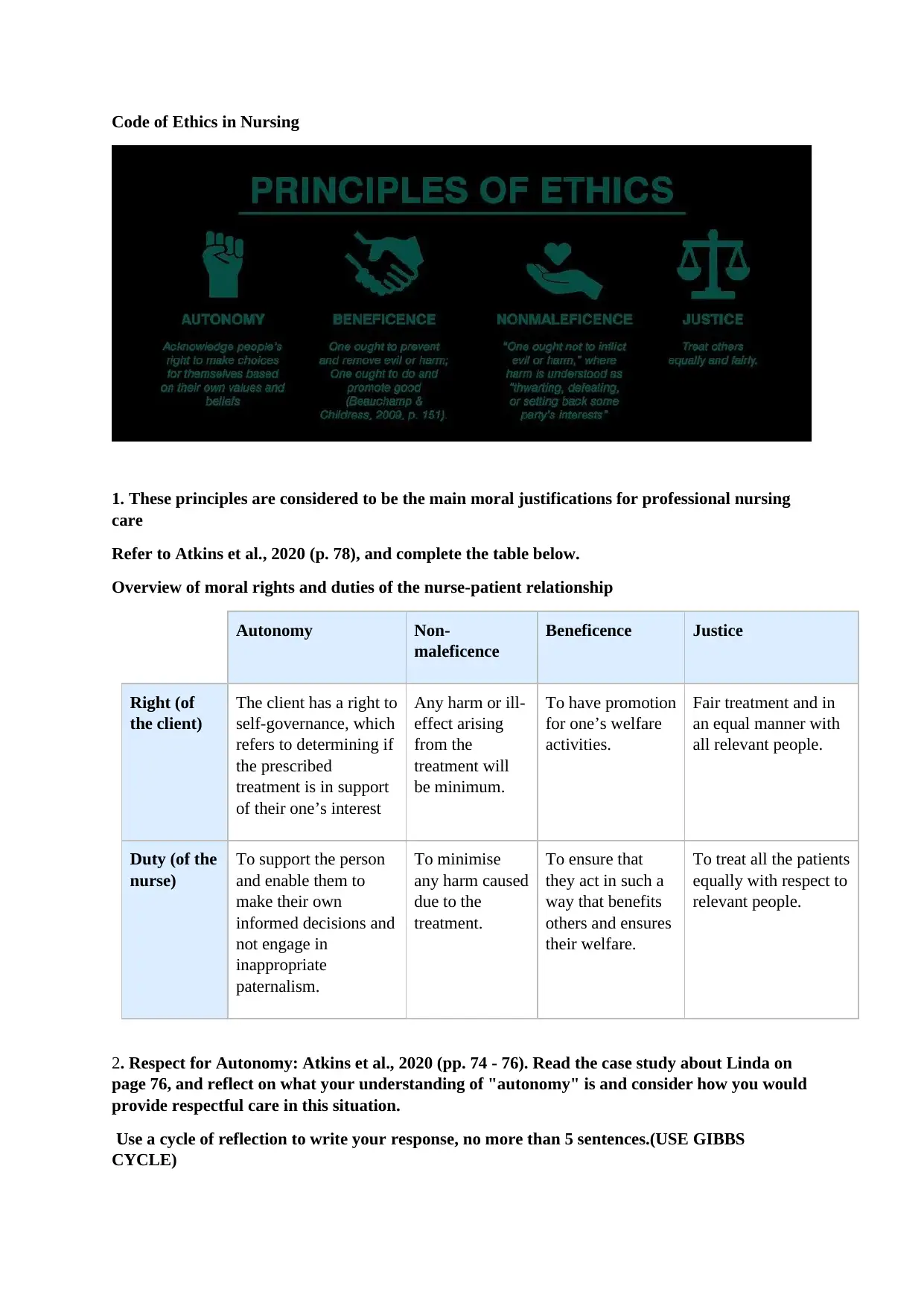
Code of Ethics in Nursing
1. These principles are considered to be the main moral justifications for professional nursing
care
Refer to Atkins et al., 2020 (p. 78), and complete the table below.
Overview of moral rights and duties of the nurse-patient relationship
Autonomy Non-
maleficence
Beneficence Justice
Right (of
the client)
The client has a right to
self-governance, which
refers to determining if
the prescribed
treatment is in support
of their one’s interest
Any harm or ill-
effect arising
from the
treatment will
be minimum.
To have promotion
for one’s welfare
activities.
Fair treatment and in
an equal manner with
all relevant people.
Duty (of the
nurse)
To support the person
and enable them to
make their own
informed decisions and
not engage in
inappropriate
paternalism.
To minimise
any harm caused
due to the
treatment.
To ensure that
they act in such a
way that benefits
others and ensures
their welfare.
To treat all the patients
equally with respect to
relevant people.
2. Respect for Autonomy: Atkins et al., 2020 (pp. 74 - 76). Read the case study about Linda on
page 76, and reflect on what your understanding of "autonomy" is and consider how you would
provide respectful care in this situation.
Use a cycle of reflection to write your response, no more than 5 sentences.(USE GIBBS
CYCLE)
1. These principles are considered to be the main moral justifications for professional nursing
care
Refer to Atkins et al., 2020 (p. 78), and complete the table below.
Overview of moral rights and duties of the nurse-patient relationship
Autonomy Non-
maleficence
Beneficence Justice
Right (of
the client)
The client has a right to
self-governance, which
refers to determining if
the prescribed
treatment is in support
of their one’s interest
Any harm or ill-
effect arising
from the
treatment will
be minimum.
To have promotion
for one’s welfare
activities.
Fair treatment and in
an equal manner with
all relevant people.
Duty (of the
nurse)
To support the person
and enable them to
make their own
informed decisions and
not engage in
inappropriate
paternalism.
To minimise
any harm caused
due to the
treatment.
To ensure that
they act in such a
way that benefits
others and ensures
their welfare.
To treat all the patients
equally with respect to
relevant people.
2. Respect for Autonomy: Atkins et al., 2020 (pp. 74 - 76). Read the case study about Linda on
page 76, and reflect on what your understanding of "autonomy" is and consider how you would
provide respectful care in this situation.
Use a cycle of reflection to write your response, no more than 5 sentences.(USE GIBBS
CYCLE)
Paraphrase This Document
Need a fresh take? Get an instant paraphrase of this document with our AI Paraphraser
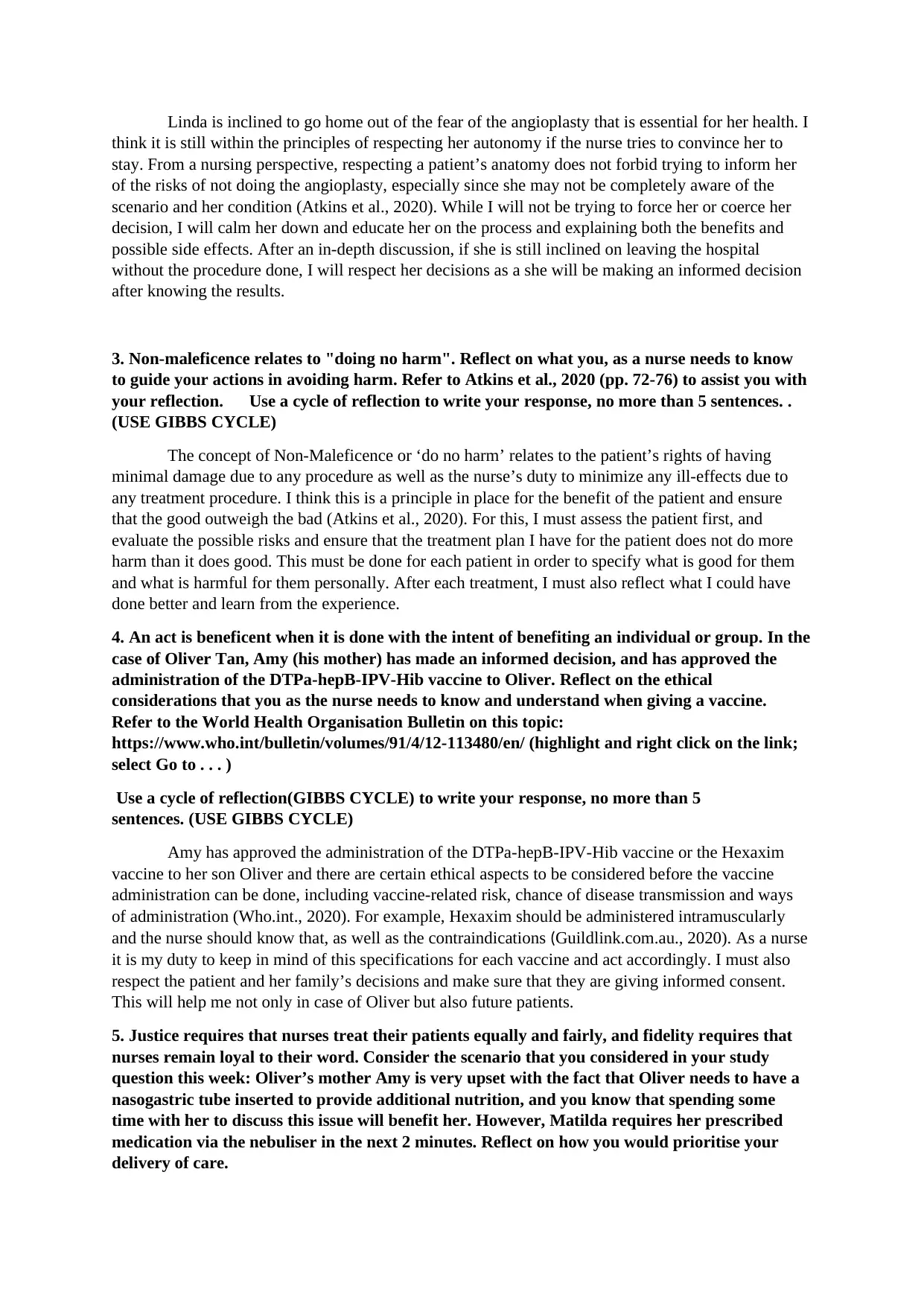
Linda is inclined to go home out of the fear of the angioplasty that is essential for her health. I
think it is still within the principles of respecting her autonomy if the nurse tries to convince her to
stay. From a nursing perspective, respecting a patient’s anatomy does not forbid trying to inform her
of the risks of not doing the angioplasty, especially since she may not be completely aware of the
scenario and her condition (Atkins et al., 2020). While I will not be trying to force her or coerce her
decision, I will calm her down and educate her on the process and explaining both the benefits and
possible side effects. After an in-depth discussion, if she is still inclined on leaving the hospital
without the procedure done, I will respect her decisions as a she will be making an informed decision
after knowing the results.
3. Non-maleficence relates to "doing no harm". Reflect on what you, as a nurse needs to know
to guide your actions in avoiding harm. Refer to Atkins et al., 2020 (pp. 72-76) to assist you with
your reflection. Use a cycle of reflection to write your response, no more than 5 sentences. .
(USE GIBBS CYCLE)
The concept of Non-Maleficence or ‘do no harm’ relates to the patient’s rights of having
minimal damage due to any procedure as well as the nurse’s duty to minimize any ill-effects due to
any treatment procedure. I think this is a principle in place for the benefit of the patient and ensure
that the good outweigh the bad (Atkins et al., 2020). For this, I must assess the patient first, and
evaluate the possible risks and ensure that the treatment plan I have for the patient does not do more
harm than it does good. This must be done for each patient in order to specify what is good for them
and what is harmful for them personally. After each treatment, I must also reflect what I could have
done better and learn from the experience.
4. An act is beneficent when it is done with the intent of benefiting an individual or group. In the
case of Oliver Tan, Amy (his mother) has made an informed decision, and has approved the
administration of the DTPa-hepB-IPV-Hib vaccine to Oliver. Reflect on the ethical
considerations that you as the nurse needs to know and understand when giving a vaccine.
Refer to the World Health Organisation Bulletin on this topic:
https://www.who.int/bulletin/volumes/91/4/12-113480/en/ (highlight and right click on the link;
select Go to . . . )
Use a cycle of reflection(GIBBS CYCLE) to write your response, no more than 5
sentences. (USE GIBBS CYCLE)
Amy has approved the administration of the DTPa-hepB-IPV-Hib vaccine or the Hexaxim
vaccine to her son Oliver and there are certain ethical aspects to be considered before the vaccine
administration can be done, including vaccine-related risk, chance of disease transmission and ways
of administration (Who.int., 2020). For example, Hexaxim should be administered intramuscularly
and the nurse should know that, as well as the contraindications (Guildlink.com.au., 2020). As a nurse
it is my duty to keep in mind of this specifications for each vaccine and act accordingly. I must also
respect the patient and her family’s decisions and make sure that they are giving informed consent.
This will help me not only in case of Oliver but also future patients.
5. Justice requires that nurses treat their patients equally and fairly, and fidelity requires that
nurses remain loyal to their word. Consider the scenario that you considered in your study
question this week: Oliver’s mother Amy is very upset with the fact that Oliver needs to have a
nasogastric tube inserted to provide additional nutrition, and you know that spending some
time with her to discuss this issue will benefit her. However, Matilda requires her prescribed
medication via the nebuliser in the next 2 minutes. Reflect on how you would prioritise your
delivery of care.
think it is still within the principles of respecting her autonomy if the nurse tries to convince her to
stay. From a nursing perspective, respecting a patient’s anatomy does not forbid trying to inform her
of the risks of not doing the angioplasty, especially since she may not be completely aware of the
scenario and her condition (Atkins et al., 2020). While I will not be trying to force her or coerce her
decision, I will calm her down and educate her on the process and explaining both the benefits and
possible side effects. After an in-depth discussion, if she is still inclined on leaving the hospital
without the procedure done, I will respect her decisions as a she will be making an informed decision
after knowing the results.
3. Non-maleficence relates to "doing no harm". Reflect on what you, as a nurse needs to know
to guide your actions in avoiding harm. Refer to Atkins et al., 2020 (pp. 72-76) to assist you with
your reflection. Use a cycle of reflection to write your response, no more than 5 sentences. .
(USE GIBBS CYCLE)
The concept of Non-Maleficence or ‘do no harm’ relates to the patient’s rights of having
minimal damage due to any procedure as well as the nurse’s duty to minimize any ill-effects due to
any treatment procedure. I think this is a principle in place for the benefit of the patient and ensure
that the good outweigh the bad (Atkins et al., 2020). For this, I must assess the patient first, and
evaluate the possible risks and ensure that the treatment plan I have for the patient does not do more
harm than it does good. This must be done for each patient in order to specify what is good for them
and what is harmful for them personally. After each treatment, I must also reflect what I could have
done better and learn from the experience.
4. An act is beneficent when it is done with the intent of benefiting an individual or group. In the
case of Oliver Tan, Amy (his mother) has made an informed decision, and has approved the
administration of the DTPa-hepB-IPV-Hib vaccine to Oliver. Reflect on the ethical
considerations that you as the nurse needs to know and understand when giving a vaccine.
Refer to the World Health Organisation Bulletin on this topic:
https://www.who.int/bulletin/volumes/91/4/12-113480/en/ (highlight and right click on the link;
select Go to . . . )
Use a cycle of reflection(GIBBS CYCLE) to write your response, no more than 5
sentences. (USE GIBBS CYCLE)
Amy has approved the administration of the DTPa-hepB-IPV-Hib vaccine or the Hexaxim
vaccine to her son Oliver and there are certain ethical aspects to be considered before the vaccine
administration can be done, including vaccine-related risk, chance of disease transmission and ways
of administration (Who.int., 2020). For example, Hexaxim should be administered intramuscularly
and the nurse should know that, as well as the contraindications (Guildlink.com.au., 2020). As a nurse
it is my duty to keep in mind of this specifications for each vaccine and act accordingly. I must also
respect the patient and her family’s decisions and make sure that they are giving informed consent.
This will help me not only in case of Oliver but also future patients.
5. Justice requires that nurses treat their patients equally and fairly, and fidelity requires that
nurses remain loyal to their word. Consider the scenario that you considered in your study
question this week: Oliver’s mother Amy is very upset with the fact that Oliver needs to have a
nasogastric tube inserted to provide additional nutrition, and you know that spending some
time with her to discuss this issue will benefit her. However, Matilda requires her prescribed
medication via the nebuliser in the next 2 minutes. Reflect on how you would prioritise your
delivery of care.
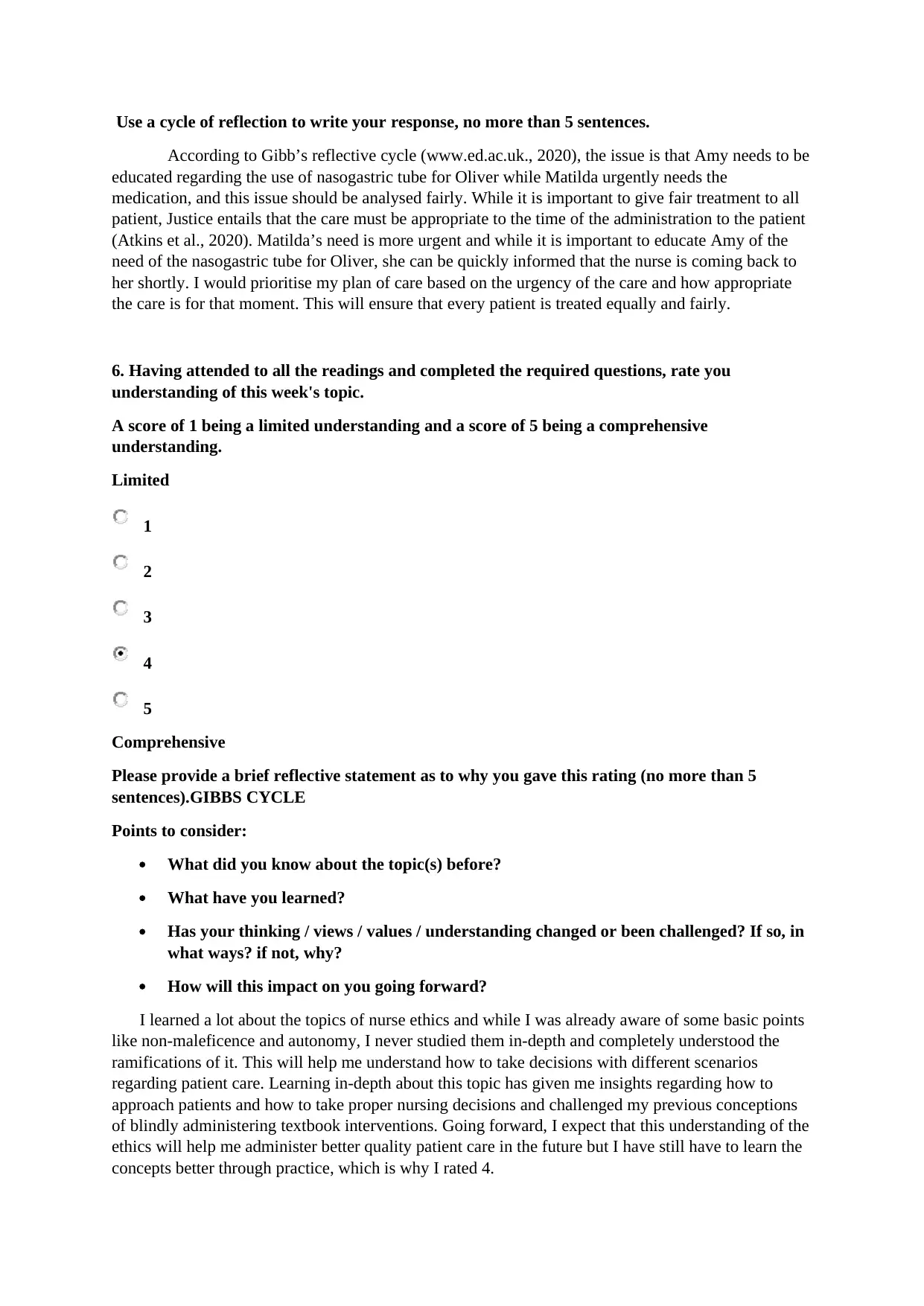
Use a cycle of reflection to write your response, no more than 5 sentences.
According to Gibb’s reflective cycle (www.ed.ac.uk., 2020), the issue is that Amy needs to be
educated regarding the use of nasogastric tube for Oliver while Matilda urgently needs the
medication, and this issue should be analysed fairly. While it is important to give fair treatment to all
patient, Justice entails that the care must be appropriate to the time of the administration to the patient
(Atkins et al., 2020). Matilda’s need is more urgent and while it is important to educate Amy of the
need of the nasogastric tube for Oliver, she can be quickly informed that the nurse is coming back to
her shortly. I would prioritise my plan of care based on the urgency of the care and how appropriate
the care is for that moment. This will ensure that every patient is treated equally and fairly.
6. Having attended to all the readings and completed the required questions, rate you
understanding of this week's topic.
A score of 1 being a limited understanding and a score of 5 being a comprehensive
understanding.
Limited
1
2
3
4
5
Comprehensive
Please provide a brief reflective statement as to why you gave this rating (no more than 5
sentences).GIBBS CYCLE
Points to consider:
What did you know about the topic(s) before?
What have you learned?
Has your thinking / views / values / understanding changed or been challenged? If so, in
what ways? if not, why?
How will this impact on you going forward?
I learned a lot about the topics of nurse ethics and while I was already aware of some basic points
like non-maleficence and autonomy, I never studied them in-depth and completely understood the
ramifications of it. This will help me understand how to take decisions with different scenarios
regarding patient care. Learning in-depth about this topic has given me insights regarding how to
approach patients and how to take proper nursing decisions and challenged my previous conceptions
of blindly administering textbook interventions. Going forward, I expect that this understanding of the
ethics will help me administer better quality patient care in the future but I have still have to learn the
concepts better through practice, which is why I rated 4.
According to Gibb’s reflective cycle (www.ed.ac.uk., 2020), the issue is that Amy needs to be
educated regarding the use of nasogastric tube for Oliver while Matilda urgently needs the
medication, and this issue should be analysed fairly. While it is important to give fair treatment to all
patient, Justice entails that the care must be appropriate to the time of the administration to the patient
(Atkins et al., 2020). Matilda’s need is more urgent and while it is important to educate Amy of the
need of the nasogastric tube for Oliver, she can be quickly informed that the nurse is coming back to
her shortly. I would prioritise my plan of care based on the urgency of the care and how appropriate
the care is for that moment. This will ensure that every patient is treated equally and fairly.
6. Having attended to all the readings and completed the required questions, rate you
understanding of this week's topic.
A score of 1 being a limited understanding and a score of 5 being a comprehensive
understanding.
Limited
1
2
3
4
5
Comprehensive
Please provide a brief reflective statement as to why you gave this rating (no more than 5
sentences).GIBBS CYCLE
Points to consider:
What did you know about the topic(s) before?
What have you learned?
Has your thinking / views / values / understanding changed or been challenged? If so, in
what ways? if not, why?
How will this impact on you going forward?
I learned a lot about the topics of nurse ethics and while I was already aware of some basic points
like non-maleficence and autonomy, I never studied them in-depth and completely understood the
ramifications of it. This will help me understand how to take decisions with different scenarios
regarding patient care. Learning in-depth about this topic has given me insights regarding how to
approach patients and how to take proper nursing decisions and challenged my previous conceptions
of blindly administering textbook interventions. Going forward, I expect that this understanding of the
ethics will help me administer better quality patient care in the future but I have still have to learn the
concepts better through practice, which is why I rated 4.
⊘ This is a preview!⊘
Do you want full access?
Subscribe today to unlock all pages.

Trusted by 1+ million students worldwide
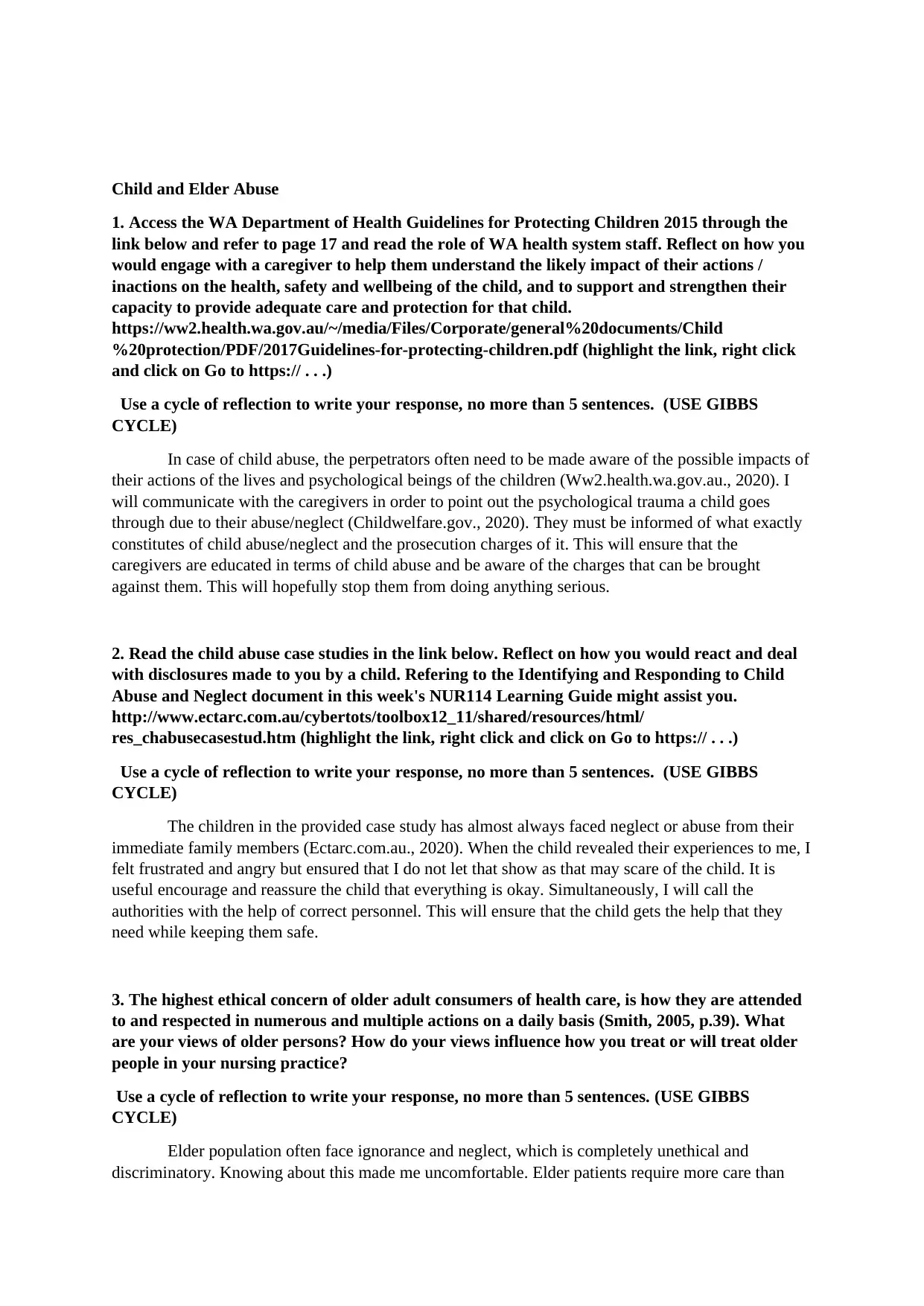
Child and Elder Abuse
1. Access the WA Department of Health Guidelines for Protecting Children 2015 through the
link below and refer to page 17 and read the role of WA health system staff. Reflect on how you
would engage with a caregiver to help them understand the likely impact of their actions /
inactions on the health, safety and wellbeing of the child, and to support and strengthen their
capacity to provide adequate care and protection for that child.
https://ww2.health.wa.gov.au/~/media/Files/Corporate/general%20documents/Child
%20protection/PDF/2017Guidelines-for-protecting-children.pdf (highlight the link, right click
and click on Go to https:// . . .)
Use a cycle of reflection to write your response, no more than 5 sentences. (USE GIBBS
CYCLE)
In case of child abuse, the perpetrators often need to be made aware of the possible impacts of
their actions of the lives and psychological beings of the children (Ww2.health.wa.gov.au., 2020). I
will communicate with the caregivers in order to point out the psychological trauma a child goes
through due to their abuse/neglect (Childwelfare.gov., 2020). They must be informed of what exactly
constitutes of child abuse/neglect and the prosecution charges of it. This will ensure that the
caregivers are educated in terms of child abuse and be aware of the charges that can be brought
against them. This will hopefully stop them from doing anything serious.
2. Read the child abuse case studies in the link below. Reflect on how you would react and deal
with disclosures made to you by a child. Refering to the Identifying and Responding to Child
Abuse and Neglect document in this week's NUR114 Learning Guide might assist you.
http://www.ectarc.com.au/cybertots/toolbox12_11/shared/resources/html/
res_chabusecasestud.htm (highlight the link, right click and click on Go to https:// . . .)
Use a cycle of reflection to write your response, no more than 5 sentences. (USE GIBBS
CYCLE)
The children in the provided case study has almost always faced neglect or abuse from their
immediate family members (Ectarc.com.au., 2020). When the child revealed their experiences to me, I
felt frustrated and angry but ensured that I do not let that show as that may scare of the child. It is
useful encourage and reassure the child that everything is okay. Simultaneously, I will call the
authorities with the help of correct personnel. This will ensure that the child gets the help that they
need while keeping them safe.
3. The highest ethical concern of older adult consumers of health care, is how they are attended
to and respected in numerous and multiple actions on a daily basis (Smith, 2005, p.39). What
are your views of older persons? How do your views influence how you treat or will treat older
people in your nursing practice?
Use a cycle of reflection to write your response, no more than 5 sentences. (USE GIBBS
CYCLE)
Elder population often face ignorance and neglect, which is completely unethical and
discriminatory. Knowing about this made me uncomfortable. Elder patients require more care than
1. Access the WA Department of Health Guidelines for Protecting Children 2015 through the
link below and refer to page 17 and read the role of WA health system staff. Reflect on how you
would engage with a caregiver to help them understand the likely impact of their actions /
inactions on the health, safety and wellbeing of the child, and to support and strengthen their
capacity to provide adequate care and protection for that child.
https://ww2.health.wa.gov.au/~/media/Files/Corporate/general%20documents/Child
%20protection/PDF/2017Guidelines-for-protecting-children.pdf (highlight the link, right click
and click on Go to https:// . . .)
Use a cycle of reflection to write your response, no more than 5 sentences. (USE GIBBS
CYCLE)
In case of child abuse, the perpetrators often need to be made aware of the possible impacts of
their actions of the lives and psychological beings of the children (Ww2.health.wa.gov.au., 2020). I
will communicate with the caregivers in order to point out the psychological trauma a child goes
through due to their abuse/neglect (Childwelfare.gov., 2020). They must be informed of what exactly
constitutes of child abuse/neglect and the prosecution charges of it. This will ensure that the
caregivers are educated in terms of child abuse and be aware of the charges that can be brought
against them. This will hopefully stop them from doing anything serious.
2. Read the child abuse case studies in the link below. Reflect on how you would react and deal
with disclosures made to you by a child. Refering to the Identifying and Responding to Child
Abuse and Neglect document in this week's NUR114 Learning Guide might assist you.
http://www.ectarc.com.au/cybertots/toolbox12_11/shared/resources/html/
res_chabusecasestud.htm (highlight the link, right click and click on Go to https:// . . .)
Use a cycle of reflection to write your response, no more than 5 sentences. (USE GIBBS
CYCLE)
The children in the provided case study has almost always faced neglect or abuse from their
immediate family members (Ectarc.com.au., 2020). When the child revealed their experiences to me, I
felt frustrated and angry but ensured that I do not let that show as that may scare of the child. It is
useful encourage and reassure the child that everything is okay. Simultaneously, I will call the
authorities with the help of correct personnel. This will ensure that the child gets the help that they
need while keeping them safe.
3. The highest ethical concern of older adult consumers of health care, is how they are attended
to and respected in numerous and multiple actions on a daily basis (Smith, 2005, p.39). What
are your views of older persons? How do your views influence how you treat or will treat older
people in your nursing practice?
Use a cycle of reflection to write your response, no more than 5 sentences. (USE GIBBS
CYCLE)
Elder population often face ignorance and neglect, which is completely unethical and
discriminatory. Knowing about this made me uncomfortable. Elder patients require more care than
Paraphrase This Document
Need a fresh take? Get an instant paraphrase of this document with our AI Paraphraser
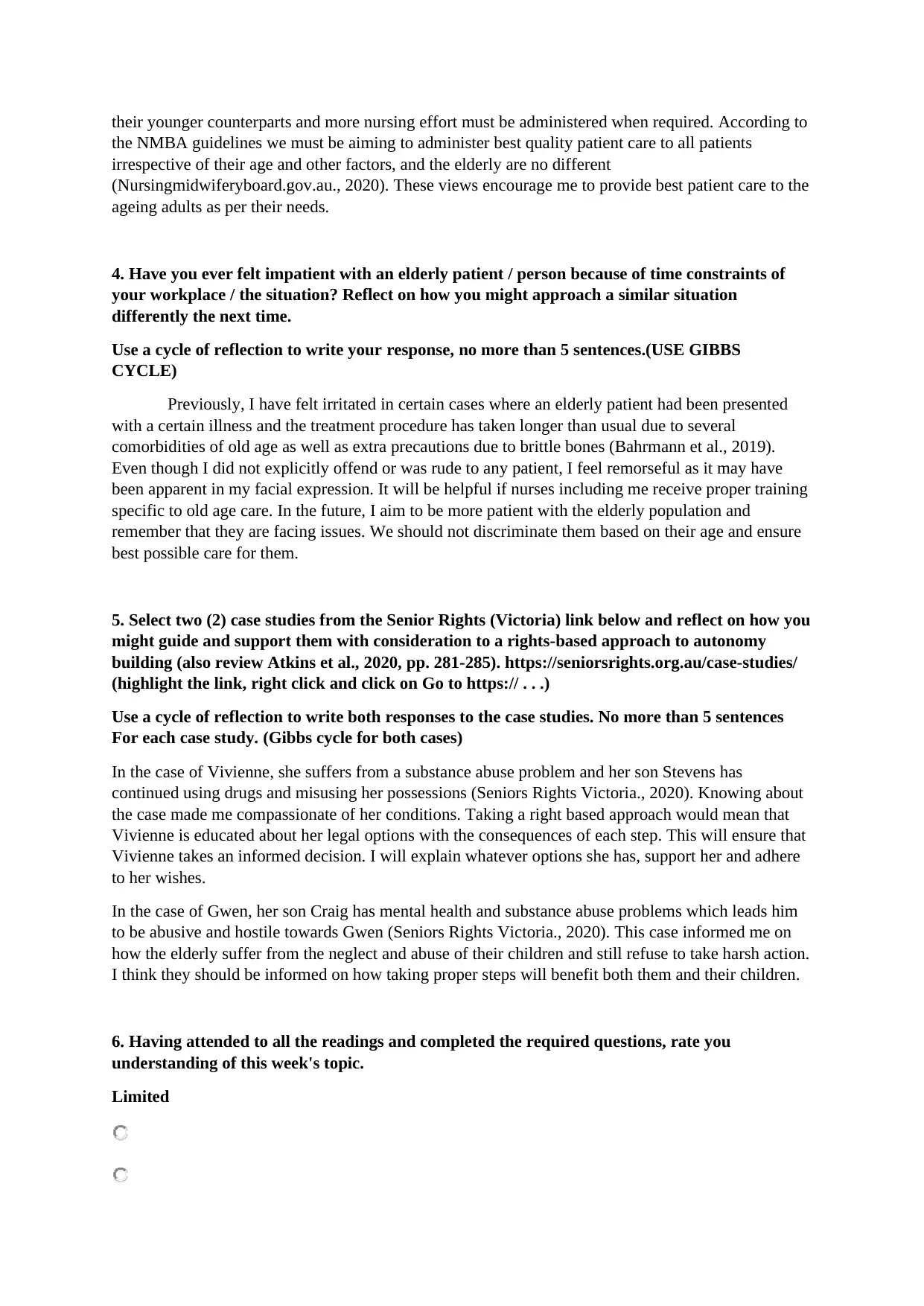
their younger counterparts and more nursing effort must be administered when required. According to
the NMBA guidelines we must be aiming to administer best quality patient care to all patients
irrespective of their age and other factors, and the elderly are no different
(Nursingmidwiferyboard.gov.au., 2020). These views encourage me to provide best patient care to the
ageing adults as per their needs.
4. Have you ever felt impatient with an elderly patient / person because of time constraints of
your workplace / the situation? Reflect on how you might approach a similar situation
differently the next time.
Use a cycle of reflection to write your response, no more than 5 sentences.(USE GIBBS
CYCLE)
Previously, I have felt irritated in certain cases where an elderly patient had been presented
with a certain illness and the treatment procedure has taken longer than usual due to several
comorbidities of old age as well as extra precautions due to brittle bones (Bahrmann et al., 2019).
Even though I did not explicitly offend or was rude to any patient, I feel remorseful as it may have
been apparent in my facial expression. It will be helpful if nurses including me receive proper training
specific to old age care. In the future, I aim to be more patient with the elderly population and
remember that they are facing issues. We should not discriminate them based on their age and ensure
best possible care for them.
5. Select two (2) case studies from the Senior Rights (Victoria) link below and reflect on how you
might guide and support them with consideration to a rights-based approach to autonomy
building (also review Atkins et al., 2020, pp. 281-285). https://seniorsrights.org.au/case-studies/
(highlight the link, right click and click on Go to https:// . . .)
Use a cycle of reflection to write both responses to the case studies. No more than 5 sentences
For each case study. (Gibbs cycle for both cases)
In the case of Vivienne, she suffers from a substance abuse problem and her son Stevens has
continued using drugs and misusing her possessions (Seniors Rights Victoria., 2020). Knowing about
the case made me compassionate of her conditions. Taking a right based approach would mean that
Vivienne is educated about her legal options with the consequences of each step. This will ensure that
Vivienne takes an informed decision. I will explain whatever options she has, support her and adhere
to her wishes.
In the case of Gwen, her son Craig has mental health and substance abuse problems which leads him
to be abusive and hostile towards Gwen (Seniors Rights Victoria., 2020). This case informed me on
how the elderly suffer from the neglect and abuse of their children and still refuse to take harsh action.
I think they should be informed on how taking proper steps will benefit both them and their children.
6. Having attended to all the readings and completed the required questions, rate you
understanding of this week's topic.
Limited
the NMBA guidelines we must be aiming to administer best quality patient care to all patients
irrespective of their age and other factors, and the elderly are no different
(Nursingmidwiferyboard.gov.au., 2020). These views encourage me to provide best patient care to the
ageing adults as per their needs.
4. Have you ever felt impatient with an elderly patient / person because of time constraints of
your workplace / the situation? Reflect on how you might approach a similar situation
differently the next time.
Use a cycle of reflection to write your response, no more than 5 sentences.(USE GIBBS
CYCLE)
Previously, I have felt irritated in certain cases where an elderly patient had been presented
with a certain illness and the treatment procedure has taken longer than usual due to several
comorbidities of old age as well as extra precautions due to brittle bones (Bahrmann et al., 2019).
Even though I did not explicitly offend or was rude to any patient, I feel remorseful as it may have
been apparent in my facial expression. It will be helpful if nurses including me receive proper training
specific to old age care. In the future, I aim to be more patient with the elderly population and
remember that they are facing issues. We should not discriminate them based on their age and ensure
best possible care for them.
5. Select two (2) case studies from the Senior Rights (Victoria) link below and reflect on how you
might guide and support them with consideration to a rights-based approach to autonomy
building (also review Atkins et al., 2020, pp. 281-285). https://seniorsrights.org.au/case-studies/
(highlight the link, right click and click on Go to https:// . . .)
Use a cycle of reflection to write both responses to the case studies. No more than 5 sentences
For each case study. (Gibbs cycle for both cases)
In the case of Vivienne, she suffers from a substance abuse problem and her son Stevens has
continued using drugs and misusing her possessions (Seniors Rights Victoria., 2020). Knowing about
the case made me compassionate of her conditions. Taking a right based approach would mean that
Vivienne is educated about her legal options with the consequences of each step. This will ensure that
Vivienne takes an informed decision. I will explain whatever options she has, support her and adhere
to her wishes.
In the case of Gwen, her son Craig has mental health and substance abuse problems which leads him
to be abusive and hostile towards Gwen (Seniors Rights Victoria., 2020). This case informed me on
how the elderly suffer from the neglect and abuse of their children and still refuse to take harsh action.
I think they should be informed on how taking proper steps will benefit both them and their children.
6. Having attended to all the readings and completed the required questions, rate you
understanding of this week's topic.
Limited
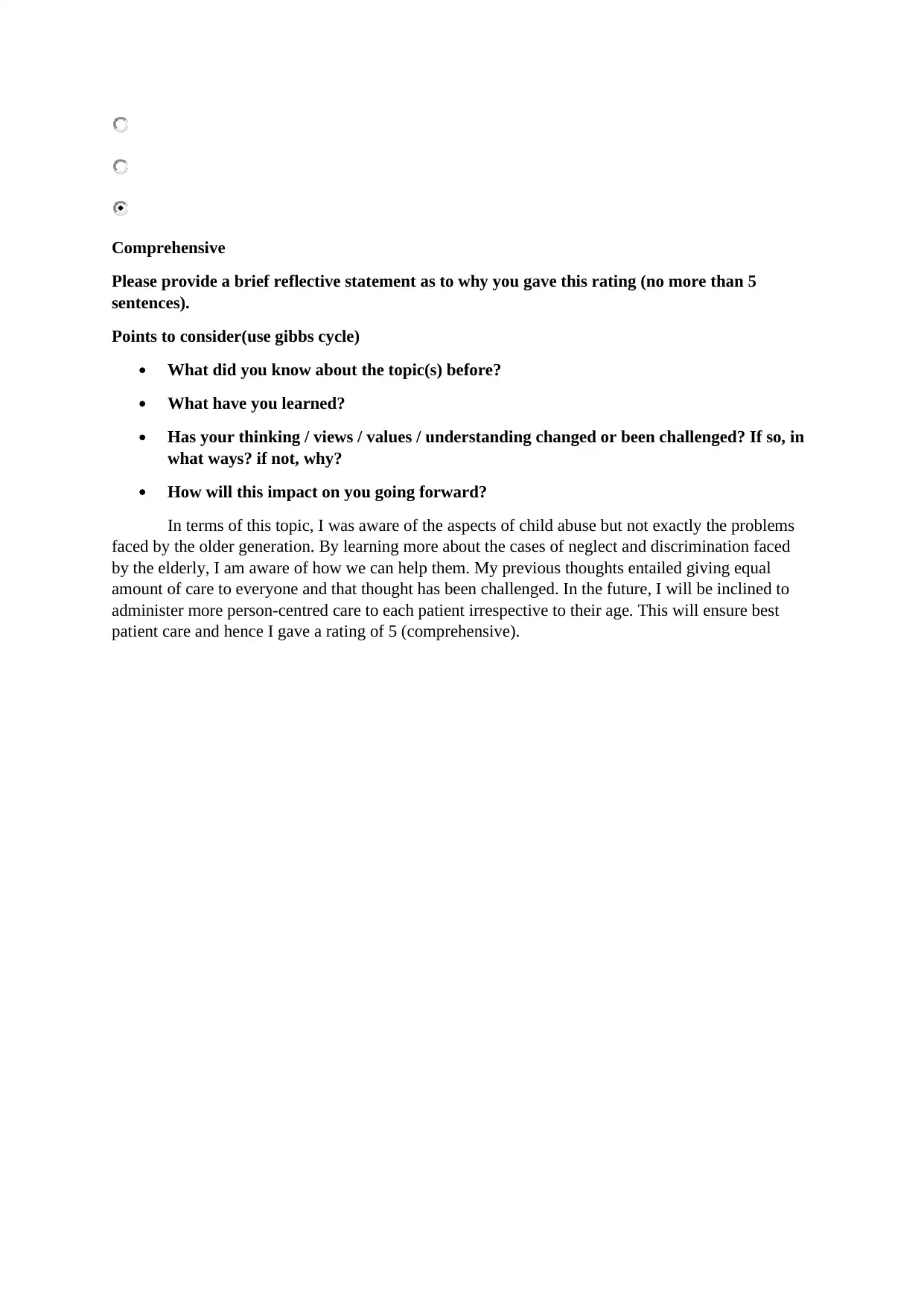
Comprehensive
Please provide a brief reflective statement as to why you gave this rating (no more than 5
sentences).
Points to consider(use gibbs cycle)
What did you know about the topic(s) before?
What have you learned?
Has your thinking / views / values / understanding changed or been challenged? If so, in
what ways? if not, why?
How will this impact on you going forward?
In terms of this topic, I was aware of the aspects of child abuse but not exactly the problems
faced by the older generation. By learning more about the cases of neglect and discrimination faced
by the elderly, I am aware of how we can help them. My previous thoughts entailed giving equal
amount of care to everyone and that thought has been challenged. In the future, I will be inclined to
administer more person-centred care to each patient irrespective to their age. This will ensure best
patient care and hence I gave a rating of 5 (comprehensive).
Please provide a brief reflective statement as to why you gave this rating (no more than 5
sentences).
Points to consider(use gibbs cycle)
What did you know about the topic(s) before?
What have you learned?
Has your thinking / views / values / understanding changed or been challenged? If so, in
what ways? if not, why?
How will this impact on you going forward?
In terms of this topic, I was aware of the aspects of child abuse but not exactly the problems
faced by the older generation. By learning more about the cases of neglect and discrimination faced
by the elderly, I am aware of how we can help them. My previous thoughts entailed giving equal
amount of care to everyone and that thought has been challenged. In the future, I will be inclined to
administer more person-centred care to each patient irrespective to their age. This will ensure best
patient care and hence I gave a rating of 5 (comprehensive).
⊘ This is a preview!⊘
Do you want full access?
Subscribe today to unlock all pages.

Trusted by 1+ million students worldwide
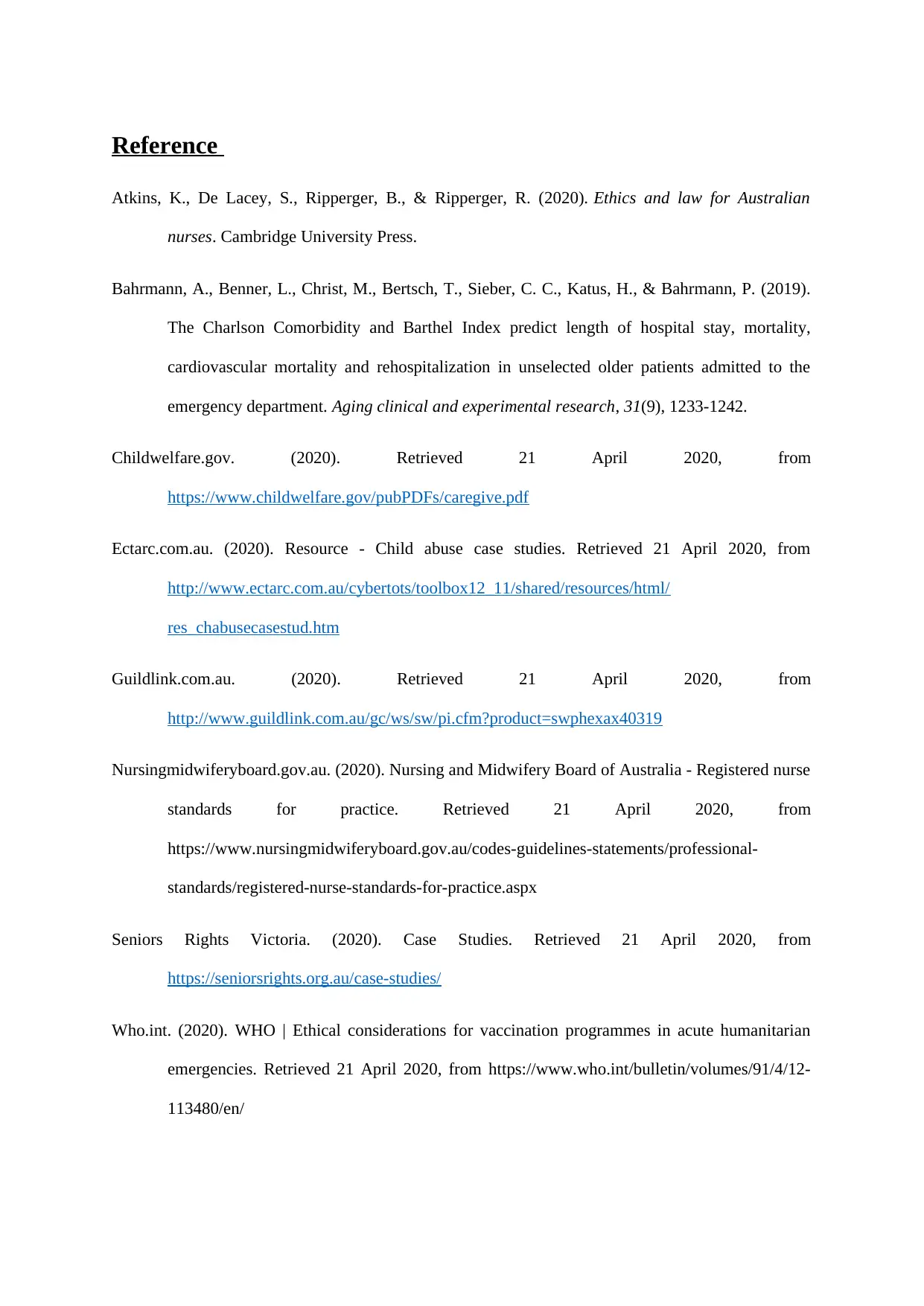
Reference
Atkins, K., De Lacey, S., Ripperger, B., & Ripperger, R. (2020). Ethics and law for Australian
nurses. Cambridge University Press.
Bahrmann, A., Benner, L., Christ, M., Bertsch, T., Sieber, C. C., Katus, H., & Bahrmann, P. (2019).
The Charlson Comorbidity and Barthel Index predict length of hospital stay, mortality,
cardiovascular mortality and rehospitalization in unselected older patients admitted to the
emergency department. Aging clinical and experimental research, 31(9), 1233-1242.
Childwelfare.gov. (2020). Retrieved 21 April 2020, from
https://www.childwelfare.gov/pubPDFs/caregive.pdf
Ectarc.com.au. (2020). Resource - Child abuse case studies. Retrieved 21 April 2020, from
http://www.ectarc.com.au/cybertots/toolbox12_11/shared/resources/html/
res_chabusecasestud.htm
Guildlink.com.au. (2020). Retrieved 21 April 2020, from
http://www.guildlink.com.au/gc/ws/sw/pi.cfm?product=swphexax40319
Nursingmidwiferyboard.gov.au. (2020). Nursing and Midwifery Board of Australia - Registered nurse
standards for practice. Retrieved 21 April 2020, from
https://www.nursingmidwiferyboard.gov.au/codes-guidelines-statements/professional-
standards/registered-nurse-standards-for-practice.aspx
Seniors Rights Victoria. (2020). Case Studies. Retrieved 21 April 2020, from
https://seniorsrights.org.au/case-studies/
Who.int. (2020). WHO | Ethical considerations for vaccination programmes in acute humanitarian
emergencies. Retrieved 21 April 2020, from https://www.who.int/bulletin/volumes/91/4/12-
113480/en/
Atkins, K., De Lacey, S., Ripperger, B., & Ripperger, R. (2020). Ethics and law for Australian
nurses. Cambridge University Press.
Bahrmann, A., Benner, L., Christ, M., Bertsch, T., Sieber, C. C., Katus, H., & Bahrmann, P. (2019).
The Charlson Comorbidity and Barthel Index predict length of hospital stay, mortality,
cardiovascular mortality and rehospitalization in unselected older patients admitted to the
emergency department. Aging clinical and experimental research, 31(9), 1233-1242.
Childwelfare.gov. (2020). Retrieved 21 April 2020, from
https://www.childwelfare.gov/pubPDFs/caregive.pdf
Ectarc.com.au. (2020). Resource - Child abuse case studies. Retrieved 21 April 2020, from
http://www.ectarc.com.au/cybertots/toolbox12_11/shared/resources/html/
res_chabusecasestud.htm
Guildlink.com.au. (2020). Retrieved 21 April 2020, from
http://www.guildlink.com.au/gc/ws/sw/pi.cfm?product=swphexax40319
Nursingmidwiferyboard.gov.au. (2020). Nursing and Midwifery Board of Australia - Registered nurse
standards for practice. Retrieved 21 April 2020, from
https://www.nursingmidwiferyboard.gov.au/codes-guidelines-statements/professional-
standards/registered-nurse-standards-for-practice.aspx
Seniors Rights Victoria. (2020). Case Studies. Retrieved 21 April 2020, from
https://seniorsrights.org.au/case-studies/
Who.int. (2020). WHO | Ethical considerations for vaccination programmes in acute humanitarian
emergencies. Retrieved 21 April 2020, from https://www.who.int/bulletin/volumes/91/4/12-
113480/en/
Paraphrase This Document
Need a fresh take? Get an instant paraphrase of this document with our AI Paraphraser

Ww2.health.wa.gov.au. (2020). Retrieved 21 April 2020, from
https://ww2.health.wa.gov.au/~/media/Files/Corporate/general%20documents/Child
%20protection/PDF/2017Guidelines-for-protecting-children.pdf
www.ed.ac.uk. (2020). Gibbs' reflective cycle. Retrieved 21 April 2020, from
https://www.ed.ac.uk/reflection/reflectors-toolkit/reflecting-on-experience/gibbs-reflective-
cycle
https://ww2.health.wa.gov.au/~/media/Files/Corporate/general%20documents/Child
%20protection/PDF/2017Guidelines-for-protecting-children.pdf
www.ed.ac.uk. (2020). Gibbs' reflective cycle. Retrieved 21 April 2020, from
https://www.ed.ac.uk/reflection/reflectors-toolkit/reflecting-on-experience/gibbs-reflective-
cycle
1 out of 8
Related Documents
Your All-in-One AI-Powered Toolkit for Academic Success.
+13062052269
info@desklib.com
Available 24*7 on WhatsApp / Email
![[object Object]](/_next/static/media/star-bottom.7253800d.svg)
Unlock your academic potential
Copyright © 2020–2025 A2Z Services. All Rights Reserved. Developed and managed by ZUCOL.




